Investment in the power battery industry remains hot, and the industry reshuffle is accelerating

|
Recently, with the booming new energy vehicle market, related supporting industry chain companies have also ushered in spring. After the investment boom in 2015, upstream and downstream companies continued to increase investment in this field in 2016, especially in expanding the production of power batteries. Industry insiders analyzed that due to policy influences this year, new energy battery and other industrial chains have also been affected, but in the long run, the industry is still full of confidence in the new energy industry, so this year's investment boom continued last year. In 2016, many new energy companies including BYD, CITIC Guoan Mengguli, and Yiwei Lithium Energy all expanded production to cope with the continued increase in demand, and the return on investment of power batteries was also quite impressive. At the same time, this year's new energy policy also focuses on subsidies and access to battery production, and the refinement of rules has also put forward many requirements for the power battery industry. Under this trend, substandard products that follow the trend will face more brutal market competition. Investment enthusiasm remains high Since the beginning of this year, with the investigation of "subsidy fraud" and the suspension of subsidies, the sales of new energy vehicles have been greatly affected. In September, the China Association of Automobile Manufacturers adjusted its annual sales forecast from 700,000 vehicles to 500,000 vehicles. The latest data shows that the cumulative sales in the first 10 months were 337,000 vehicles. An insider of a battery company said, "This year, due to policy influence, battery manufacturers' shipments are not as much as expected, but the investment boom is still continuing." According to incomplete statistics, BYD's Qinghai lithium battery project and power battery material production and recycling project started at the end of October; in June, Mengguli signed a battery project investment agreement with Tianjin; Yiwei Lithium Energy's power battery production capacity is expanding rapidly, and the second phase plans to build 2.5GWh ternary and 0.7GWh lithium iron phosphate, which are expected to be put into production in the first quarter of 2017. According to the statistics of China's private equity market in the third quarter of 2016 released by Zero2IPO Research Center, the total investment in the automotive industry grew rapidly in the third quarter, ranking third in the industry, reaching 10.742 billion yuan. Among them, new energy vehicles, auto parts manufacturing and automotive Internet platforms are all hot investment areas in the automotive industry. Wang Zhikuo, project manager of the marketing department of Mengguli, also said, "The entire industry is still optimistic about the future trend of new energy, so they are increasing investment to prepare for future demand. Since July, although the policy is not yet clear, many bus companies have resumed orders, and Mengguli has entered full capacity operation." At the same time, the investment income of power batteries is also considerable. Taking the listed company Yiwei Lithium Energy as an example, the third quarter report shows that the company achieved operating income of 627 million yuan in the third quarter, an increase of 86.21% year-on-year and 43.87% quarter-on-quarter compared with the second quarter; and achieved a net profit attributable to shareholders of listed companies of 69.8 million yuan, an increase of 118.28% year-on-year and 36.01% quarter-on-quarter. Entering the industry elimination period Like new energy vehicles, the development of the new energy supply chain has only been a few years, and it has developed rapidly mainly driven by policies and capital. After a large-scale entry of capital, the industry has started a survival of the fittest mechanism after a period of development. According to the research report "Analysis of the Current Situation of the Upstream Power Battery Market in the New Energy Vehicle Industry Chain" released by CITIC Consulting, in 2015, more than 20 vehicle, power battery and other related enterprises planned or had already started production in the power battery and upstream raw materials fields, with a minimum of tens of billions and a maximum of hundreds of billions. The investment boom in the new energy industry chain reached a very high level in 2015. Behind this wave of investment, many problems have also emerged. For example, after the initial large-scale construction and land enclosure, many charging pile companies have begun to see abandoned charging piles and low utilization rates this year. And after several policy adjustments this year, power battery companies will face more detailed rules and restrictions. Regarding policy adjustments, Wang Zhikuo said, "The battery industry is greatly affected by policies, and one move affects the entire body. At present, the new subsidy policy has not been determined, and there are many rumors circulating among companies, and everyone is still waiting and watching." In terms of the detailed rules, in March this year, the Ministry of Industry and Information Technology officially released the "Automotive Power Battery Industry Standard Conditions". The new energy vehicle promotion catalogue is bundled with the "Automotive Power Battery Industry Standard Conditions", which means that new energy vehicle products that use batteries that are not included in the catalogue cannot receive subsidies. Although it was later stated that it is not a simple "link", there will still be many relevant restrictions. The "Analysis and Tips on the Development of the New Energy Vehicle Industry" released by China Automotive Research Institute in July showed that in terms of power batteries, there are about 200 individual power battery production enterprises and more than 300 system enterprises supporting domestic new energy vehicle companies. However, as of June this year, there were only 57 companies included in the four batches of the catalogue. Previously, Wang Binggang, leader of the expert group of the National New Energy Vehicle Technology Innovation Project, said in an interview with reporters, "At present, there are not too few battery companies in China, but too many." It can be imagined that with the further refinement and adjustment of the rules in the future, power battery manufacturers will face further reshuffle. As a winner of Toutiao's Qingyun Plan and Baijiahao's Bai+ Plan, the 2019 Baidu Digital Author of the Year, the Baijiahao's Most Popular Author in the Technology Field, the 2019 Sogou Technology and Culture Author, and the 2021 Baijiahao Quarterly Influential Creator, he has won many awards, including the 2013 Sohu Best Industry Media Person, the 2015 China New Media Entrepreneurship Competition Beijing Third Place, the 2015 Guangmang Experience Award, the 2015 China New Media Entrepreneurship Competition Finals Third Place, and the 2018 Baidu Dynamic Annual Powerful Celebrity. |
<<: Where will the new energy vehicle industry go after Trump takes office?
>>: JIMI Zhong Bo: There is only one secret to support the rapid development of screenless TVs
Recommend
The other side of the layoff wave: Don’t want to “roll” anymore, want to be “N+1”
Yuan Dian clearly remembers that the number of pe...
What should I do if the website articles are not included? How to solve the problem of website not being included?
What should I do if the website articles are not ...
App Store 10-year data report: In the past year, games only accounted for 31% of downloads, but revenue was as high as 75%.
Since its launch in 2008, Apple App Store has bee...
Weibo hot search was shut down for a week, resulting in a loss of tens of millions. Revealing the industrial chain behind Weibo hot search!
At 9:30 p.m. on January 27, Weibo shut down the “...
Dongfeng withdrew its employees but not its investment. Can the lonely Dongfeng Yulon still have fun?
It is reported that Dongfeng Motor Corporation, a...
Feel the immersive music atmosphere, Sony WH-1000XM3 presents perfect noise reduction technology
How can you enjoy the ocean of music without a pa...
2020 Jiangxi College Entrance Examination Schedule, Jiangxi College Entrance Examination Admission Ticket Printing Entrance Official Website
The Jiangxi Province College Entrance Examination...
How to maintain seed users and enable them to optimize and spread products?
Maintaining seed users is actually a matter of co...
3 pitfalls of community operation
Community products have natural advantages in use...
[Popular Science of Chinese Military Technology] From "nothing to nothing" to "hitting the target from a hundred steps away", the evolution of tank artillery aiming
In the brutal trench warfare of World War I, both...
Post-90s beauty operator: How I planned an event with 10 million daily traffic in 5 days!
I'm Zongzi, a post-90s planner who combines a...
How to make a 400 call? How much does a 400 call cost?
400 telephone numbers can enhance a company's...
Soul-searching question: How can humans make robots "moral"?
With the rapid development of artificial intellig...
The booster behind the location-based security smart hardware
If you have seen the movie "Dear", you ...
When atrial fibrillation or palpitations occur, how should you deal with this unusual heartbeat?
"My heart is pounding, tell me what to do?&q...









